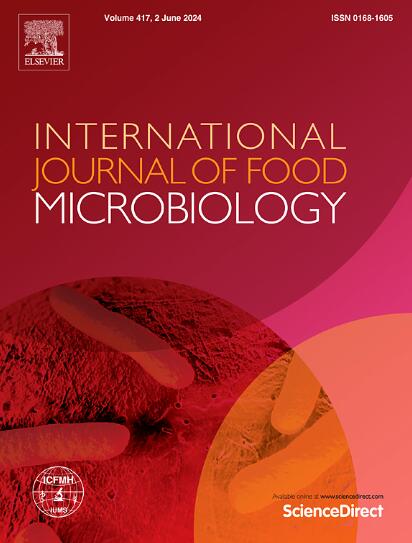The resistome of pasteurized and raw milk cheeses from the state of Vermont
IF 5.2
1区 农林科学
Q1 FOOD SCIENCE & TECHNOLOGY
International journal of food microbiology
Pub Date : 2025-06-27
DOI:10.1016/j.ijfoodmicro.2025.111333
引用次数: 0
Abstract
This study investigates the resistome dynamics in cheese production, focusing on both raw milk and pasteurized varieties comparing a standard and lytic method of DNA extraction. Metagenomic analysis revealed the presence of single nucleotide polymorphism (SNP) confirmed antimicrobial resistance genes (ARGs) in core and rind samples of cheeses at different stages of ripening. No statistical significance was found between the extraction methods for antimicrobial resistance gene (ARG) classes. In pasteurized cheese, the resistome was influenced by the initial microbial composition and ripening period, with limited ARGs detected due to pasteurization. Nonetheless, detection of class B β-lactamase and Fosfomycin B resistance genes was observed in the pasteurized cheese core, possibly harbored by Bacillus cereus. Raw milk cheese exhibited a distinct resistome profile, with fluctuations in macrolide and oxazolidinone resistance genes associated with changes in microbial populations during ripening. Notably, the likely presence of multi-drug resistance genes in Lactococcus lactis highlights the importance of understanding resistance mechanisms in starter cultures. The study emphasizes the need for antimicrobial stewardship and hygiene practices in dairy production to mitigate the spread of resistance genes. Despite sequencing biases, this research contributes valuable insights into the cheese resistome, advocating for future studies to employ enhanced sequencing methods for comprehensive analysis and to develop practical strategies for resistance management in dairy products.
来自佛蒙特州的巴氏杀菌和生牛奶奶酪的抗性组
本研究调查了奶酪生产中的抵抗组动力学,重点研究了原料奶和巴氏灭菌品种的DNA提取的标准方法和裂解方法。宏基因组分析显示,在不同成熟阶段的奶酪核心和外皮样品中存在单核苷酸多态性(SNP)证实的抗微生物药物耐药性基因(ARGs)。抗菌药物耐药基因(ARG)类别的提取方法间差异无统计学意义。在巴氏灭菌的奶酪中,抵抗组受初始微生物组成和成熟时间的影响,由于巴氏灭菌,检测到的ARGs有限。然而,在巴氏灭菌的干酪核中检测到B类β-内酰胺酶和磷霉素B耐药基因,可能是蜡样芽孢杆菌的宿主。生牛奶奶酪显示出独特的抗性谱,大环内酯和恶唑烷酮抗性基因的波动与成熟过程中微生物种群的变化有关。值得注意的是,乳酸乳球菌中可能存在多重耐药基因,这突出了了解发酵剂培养物耐药机制的重要性。该研究强调需要在乳制品生产中加强抗微生物药物管理和卫生实践,以减轻耐药基因的传播。尽管测序存在偏差,但该研究为奶酪抗性组的研究提供了有价值的见解,倡导未来研究采用增强的测序方法进行全面分析,并制定乳制品抗性管理的实用策略。
本文章由计算机程序翻译,如有差异,请以英文原文为准。
求助全文
约1分钟内获得全文
求助全文
来源期刊
CiteScore
10.40
自引率
5.60%
发文量
322
审稿时长
65 days
期刊介绍:
The International Journal of Food Microbiology publishes papers dealing with all aspects of food microbiology. Articles must present information that is novel, has high impact and interest, and is of high scientific quality. They should provide scientific or technological advancement in the specific field of interest of the journal and enhance its strong international reputation. Preliminary or confirmatory results as well as contributions not strictly related to food microbiology will not be considered for publication.

 求助内容:
求助内容: 应助结果提醒方式:
应助结果提醒方式:


